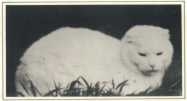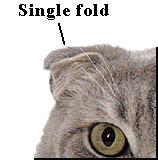
Susie
de Bellissimo (N)
British Shorthairs
and Scottish Folds
|
This page
will no longer be updated! |
Scottish Fold
HISTORY

Susie
The story began in 1961, at Coupar Angus, in the Tayside region of Scotland, Northwest of Dundee. William Ross, a shepherd, returning from his day's work, passed by the neighboring McRae's farm and noticed a white cat playing in the front yard. Its ears were folded forward and downward.
Knowing his wife, Mary, had an interest in cats, William told her what he had seen. Mary, very intrigued, decided to ask the McRaes about the cat.
The cat's name was Susie and her parents were barn cats. Her mother was killed in a farm accident. No one knew about the father. There was another folded ear male in Susie's litter; but, he had disappeared.
The Rosses were promised a folded ear kitten from Susie's next litter. Two years later, in 1963, they received a white folded ear female. They named the kitten Snooks, who became the beginning lineage of the Scottish Fold.
Snooks was first bred to an unknown red tabby male. In the litter, only one male kitten had folded ears. This white male, named Snowball, was later mated with Lady May, a white British Shorthair. Five folded ear kittens were produced.
Snooks was next bred to Ryelands Regal Gent, a blue British Shorthair. In 1969, two folded ear kittens were born in this second litter - Denisla Hester and Denisla Hector, which, along with Snowball and Lady May's kittens, became the foundation for the future.
When the Rosses decided to name their cattery in order to register kittens of this new "breed" they chose "Denisla" after the Den and Isla rivers near their home. This was about 1966.
Securing the help of English geneticists to start a breeding program, and using farm cats and British Shorthairs, the Rosses produced several kittens. These first folded ear cats were known as "lops", after the lop-eared rabbits. By 1966, there were renamed "Scottish Folds".
Susie, the original fold, was a loose fold which means the tips of her ears bent forward about halfway up the ear. This is now called a single fold. Today's folds have ear folds ranging from the loose single fold to the very tight triple fold.


Triple fold
In the mid 1960s, Pat Turner, a cat breeder and geneticist, became involved in the development of the Fold. Over the next 3 years she oversaw the breedings which produced 76 kittens - 42 with folded ears and 34 with straight ears. She and Peter Dyte, another British geneticist, agreed that the gene mutation responsible for folded ears is a simple dominant. This means that if a kitten inherits a gene from one parent for straight ears and one from a parent with the gene for folded ears, it will be a fold. They also learned that the original cats carried the longhair gene.
The breed was accepted by the Governing Council of the Cat Fancy in England; but, in 1971, registration was closed. The reasoning given was that it was too difficult to keep Folds free of ear mite infestation (which was later proven false), and because several blue-eyed white cats that were used in breeding produced too many kittens that were born deaf.
A faction in the British Cat Fancy felt that the Scottish Fold would be prone to ear infections and deafness. They campaigned to prevent their acceptance for registry in Great Britain. Folds are still not accepted for registry in registries of Great Britain and Europe.
Mrs. Ross arranged for some of her folds to be shipped to Neil Todd, Ph.D., a geneticist in Newtonville, MA in the early 1970's. The first American born litter arrived Nov. 30, 1971. After his study ended, some folded kittens were given to first one CFA affiliated breeder who gave some to another, etc., until the shorthair Scottish Folds were accepted by ACA for registration in 1973, ACFA and CFA in 1974. TICA was the first registry to recognized the longhairs for championship competition in the 1987-88 show season and CFA followed in 1993-94. Salle, a well-known Manx breeder, became the first "breeder" in the United States to work with the Scottish Folds.
In August 1972, Briony Sivewright, from Scotland, and her husband were transferred to Hill AFB in Utah. She received a blue cream and white Fold, which she showed to Ann Kimball and Karen Votava. The cat was bred to one of Ann's American Shorthairs and produced three folded ear kittens. One remained with Ann, another went to Karen Votava, and the third went to Salle.
Although the Ross' had to give up their efforts in their own country to develop and raise these adorable cats, they will always be regarded in America as the founders of the breed.
There are only a few breeders of scottish folds in Europe, most breeders are situated in America.
HOME | CATTERY
| OUR
CATS | KITTENS | KITTENS FOR
SALE | EXPECTED/PLANNED | IN MEMORY
|
| BRI
STANDARD | BRI
HISTORY | BRI CHARACTER | EMS Colour codes |
| SF STANDARD |
SF HISTORY
| SF CHARACTER
|
| GRETE | GEIR
| LINDA | ROBIN
| AMAZOONAS | LINKS
| NEWS |
| SIGN GUESTBOOK
| VIEW GUESTBOOK
| MAIL
Last updated 8.September 2004
You are visitor:
![]()